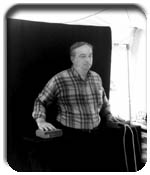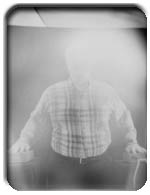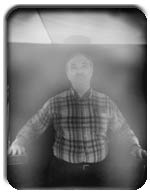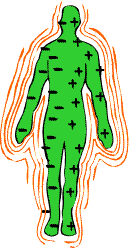|
At psychic fairs and other popular venues,
"aura" photographic portraits are all the rage. But are they really what they are claimed to be?
According to belief that has persisted since ancient times, the aura is a radiance from the
"energy field" that supposedly emanates from and surrounds all living things. It is perceived not by ordinary vision but by
clairvoyance. Although "no evidence has been found to prove its existence" (Guiley 1991), the concept has thrived as pseudoscience.
For example, in his 1911 book, The Human Atmosphere, Dr. Walter J. Kilner claimed he could not only see the aura and use it for medical diagnoses, but he also accepted
the validity of nonexistent "N-rays" and clairvoyance. The British Medical Journal rightly scoffed.
Today self-professed "medical intuitives" like Caroline Myss (1997) claim to describe the nature of people's physical diseases by reading their "energy field." Thus Myss
"can make recommendations for treating their condition on both a physical and spiritual level." She calls this supposedly
auric process "energy medicine," but offers no scientific evidence to substantiate her alleged powers. (New Age
magazine stated Myss no longer gives readings, and quoted me as terming the practice "offensive and dangerous" [Koontz 2000,
66, 102].)
The human body does, in fact, give off certain radiations, including weak electromagnetic
emanations (from the electrical activity of the nerves), chemical emissions (some of which may be detected, for instance,
as body odor), sonic waves (from the physical actions within the body), etc. Paranormalists sometimes equate these radiations
with the aura (Permutt 1988, 57-58), but they do not represent a single, unified phenomenon, nor have they been shown to have
the mystical properties attributed to auras.
If psychics could actually see the purported energy fields, one wonders why, as Guiley (1991)
observes, their composition "is the subject of conflicting opinions." She states: "No two clairvoyants see exactly the same
aura. Some say they see the entire aura, divided into different layers or bodies, while others say they see only parts of
the aura." In fact, tests of psychics' abilities to see the alleged radiant emanations have repeatedly met with failure. One
test, for example, involved placing either one or two persons in a completely dark room and asking the alleged psychic to
state how many auras she saw. Only chance results were obtained (Loftin 1990). James Randi conducted another test for a television
special, offering $100,000 for successful results. The psychic challenger selected ten people she maintained had clearly visible
auras, and agreed that the auras would extend above the screens behind which-unseen by her-the people were to stand. Unfortunately,
in choosing which screens supposedly had people behind them, the psychic got only four out of ten correct guesses-less than
the five that chance allowed (Steiner 1989).
Once at a psychic workshop I volunteered as the subject whose aura others were instructed
to visualize. I stood in front of a blank wall while the instructor noted how my energy field expanded and contracted as I
inhaled and exhaled. Actually, I held my breath for long periods, while raising and lowering my chest and shoulders to simulate
breathing. Such is the power of suggestion that some imaginative initiates "saw" the alleged effect despite the negating conditions.
In addition to purportedly seeing the aura, some mystics claim they can actually detect it
by such means as dowsing. For example, while inspecting a crop circle near Silbury Hill in southern England, I had my auric
field checked by a local dowser who had used his divining rod to convince himself the circle was genuine, produced by earth
spirits. Although my aura supposedly measured only a few inches, after I had compliantly meditated for a few moments it expanded
to several feet - or so the rhabdomancer claimed (Nickell 1995).
Not surprisingly, there have been various attempts to photograph the aura. For example, in
the 1890s a French army officer tried to record alleged psychic force fields on photographic plates but with reportedly poor
results (Permutt 1988, 89). Claims that the aura has been successfully photographed are typically based on a misunderstanding
of the simple scientific principles involved. For instance, while infrared photography can produce images of people with aura-like
bands of radiance around them, these are actually only emanations of body temperature (Nickell 1994; Permutt 1988, 123).
More serious claims that the aura could be demonstrated scientifically through Kirlian photography
were publicized in the 1970s. In this non-camera technique a high-voltage, high-frequency electrical discharge is applied
across a grounded object. The "air glow" or "aura" that is yielded can be recorded directly onto a photographic plate, film,
or paper. Such Kirlian images (named for the Russian inventor of the process, Semyon Kirlian) show fuzzy glows around fingers,
leaves, and other objects (Ostrander and Schroeder 1971).
Although the Kirlian aura was claimed to present information about the "bioplasma" or "life-energy"
of the object, actually it is only "a visual or photographic image of a corona discharge in a gas, in most cases the ambient
air." Moreover, experiments have failed to yield any evidence that the coronal pattern is related "to the physiological, psychological,
or psychic condition of the sample," but instead only to finger pressure, moisture, and other mechanical, environmental, and
photographic factors (some twenty-two in all). Skeptics observed that even mechanical objects, such as coins or paper clips,
could yield a Kirlian "aura" (Watkins and Bickel 1986).
Following in the Kirlian tradition is a development called Aura Imaging photography introduced
in 1992 by Guy Coggins, a California entrepreneur with a background in electronic engineering. Coggins's Aura Camera 6000
is a combined optical-electrical system that produces a Polaroid color photograph of the subject together with his or her
"electromagnetic field or aura." Coggins's company, Progen, also markets a software program called WinAura that allows one to "see the aura move and change like a movie
in real time on your computer or TV screen" and to "print your aura image from your computer printer" (Progen 1999).
Coggins concedes that most who purchase and use his device fail to understand how it works.
"These people live quite different lives than the rest of us," Coggins told a reporter. "Sometimes, we have trouble explaining
to them how to plug the thing in" (Sullivan 1999). Scientists, on the other hand, continue to be skeptical of all claims made
about the alleged aura. Observes Sullivan (1999):
The reason little of the research on energy, auras, and energy healing has been accepted by the scientific
community is that it's unpredictable. To be proven as concrete, science demands that an action, performed in the same way
under the same circumstances, must yield the same results. No such luck in this area, Coggins admits.
"None of this is duplicatable. It
works once, but maybe not the next time. So there's no way to prove it, according to scientific standards."

Illustration 2
Author posing for “aura” photograph with hand placed on sensors.
But what about Coggins's aura-imaging technology? Can a photograph lie? I was intrigued by
the process, which I found demonstrated at a psychic fair at Olcott Beach in western New York (July 17, 1999). There I posed
for my very own "Full Body Aura Photograph." Actually, I had two such photos made (at $20 each), and therein lies a story.
I was invited to stand facing the camera with my hands on electrical modules wired to both the camera and a computer printer
(figure 1). I soon received a color Polaroid photograph plus a printout (copyrighted by Progen) showing a simplistic asterisk-rendered
outline of a human figure arrayed with letters that indicated color areas ("B" for blue, "G" for green, etc.). These roughly
correlated with the areas of colored light in the photo.
The photograph (figure 2) showed such an intense "energy field" of yellow-bordered
white light that it washed out my facial features. The printout designated this area as "Yellow" and interpreted it (in grammatically
unparallel fashion) as "Sunny, Exhilaration." (Small areas of "Green"-"Healing, Teaching"-were shown on either side.) One
of the enterprise's "experienced Certified Aura Imaging Counselors" told me the bright area of light showed I had prominent
"spiritual" qualities.
As I reflected on what had transpired, it occurred to me that a single such picture is little
more than a novelty, while two would represent the beginning of an investigation. When I returned to the booth for a second
portrait, the proprietor seemed discomfited, asking me why I wanted another. I expressed curiosity, wondering aloud whether
different moods would affect the outcome. She said it would, jokingly cautioning me not to think about sex and - when I asked
what would happen - telling me the color red would predominate.

Illustration 3
“Full-body aura photograph” of author with dramatic yellow-white burst of radiance.
In fact, however, while I (blush) thought vividly about the warned-against subject (purely
in the interests of science, of course), my aura was depicted in the resulting photo (figure 3) as predominately blue ("Peaceful,
Contemplative") and green ("Healing, Teaching"). Since I was accompanied by some college students (summer interns at the Center for Inquiry), I was told that the results were due to the fact that, obviously, I had been "teaching" the students in the
interim between photo sessions.

Illustration 4
Second
aura
photo,
made only minutes after the first, with subdued tones of blue an red/
My own interpretation was that the radically different photos demonstrated a lack of any
consistency that might justify people thinking of their aura as an expression of their inherent individuality. (An accompanying
brochure spoke to the reader about "your personal energy field," and Coggins insists, "The aura is individual, like a thumbprint"
[Ziegler 1996].) Instead, the disparity seemed attributable to an ever-changing light display that did not seem to correspond
to moods-at least not on the occasion I tested the system.
Indeed, a look at the actual process employed-described by Coggins as "intensified Kirlian
imaging"-shows it to be not the actual image of the body's unseen image field but the imitation of such a field based primarily
on something called skin resistance. That is one of the physiological variables measured by a galvanometer as part of a polygraph
or "lie detector," whereby an unfelt electrical current passes through the subject's hands and detects sweat-gland activity
associated with nervousness. (Cheap lie detectors-as well as the "E-meters" used by Scientologists in their controversial
pyschotherapeutic technique called "auditing" [Behar 1999]-are essentially only galvanometers.)
As one source explains the aura camera's technique (while neglecting to mention that the
electrical current is induced):
The hand plates on the electronic modules contain sensors that are located at specific acupuncture points
on each hand. Each one of the points corresponds to a different area of the body.
Coggins said the sensors pick up the
electrical current on the skin at each of those locations. This current is called "skin resistance."
Next, according to this source:
The computer plots the information from the sensors. Within the camera is a liquid crystal display [LCD]
of different colors. Each electrical frequency plotted by the computer is assigned a different color. The higher frequencies
are assigned warmer colors-reds, yellows, oranges. The lower frequencies fall toward the cooler end of the spectrum-blues
and purples. Greens and shades like turquoise, aquamarine, and yellow-green fall into the center of the vibrational spectrum.
Coggins said he worked with psychics who helped him interpret the frequencies, and the colors they could represent. People
with a lot of high energy in their field-red and orange-are described by most clairvoyants as vibrant and passionate.
Finally,
The LCD flashes lights according to the pattern and frequencies plotted by the computer. The Polaroid
film is thus exposed to the colored lights, which show up on the photograph in the areas of the body where the corresponding
electrical currents were sensed (Sullivan 1999). This torturous process-involving
obtaining dubious electrically stimulated data from the hands, extrapolating it by analogy to acupuncture to the entire body,
translating the electrical frequencies into alleged color equivalents, and then substituting for them simple flashes of colored
lights-can scarcely be called photographing the aura. As is typically the case with photographs of alleged paranormal phenomena,
what you see is not what you get.
Acknowledgments
I am grateful
to Tom Flynn, Director of Inquiry Media Productions, for considerable help with this investigation and Tim Binga, Director
of the Center for Inquiry Libraries, for research assistance.
References
·
Baker, Robert A., and Joe Nickell. 1992.
Missing Pieces. Buffalo, N.Y.: Prometheus Books, 105-107.
·
Behar, Richard. 1999. The thriving cult of
greed and power. Time, May 6, 50-57.
·
The British Medical Journal. 1912. January
6; quoted in the foreword of Kilner 1911 (1984 ed.)
·
Cavendish, Richard, ed. 1974. Encyclopedia of the Unexplained. London: Routledge & Kegan Paul, 48
·
Guiley, Rosemary Ellen. 1991. Harper's Encyclopedia of Mystical & Paranormal Experience. New York: HarperCollins, 40-42.
·
Kilner, W. J. 1911. The Human Atmosphere; reprinted as The Aura. York Beach, Maine: Samuel Weiser, 1984.
·
Koontz, Katy. 2000. The new health detectives.
New Age, January/February, 64-67, 102-110.
·
Loftin, Robert W. 1990. Auras: Searching
for the light. Skeptical Inquirer 14(4) (Summer): 403-409.
·
Myss, Caroline. 1997. Why People Don't Heal and How They Can. New York: Harmony Books, xi.
·
Nickell, Joe. 1994. Camera Clues. Lexington, Ky.: University Press of Kentucky, 178-179.
·
--. 1995. Crop circle mania wanes. Skeptical Inquirer 19(3) (May/June): 41-43.
·
Ostrander, Sheila, and Lynn Schroeder. 1971.
Psychic Discoveries Behind the Iron Curtain. New York: Bantam, 200-213.
·
Permutt, Cyril. 1988. Photographing the Spirit World. Wellingborough, England: The Aquarian Press.
·
"Photography." 1960. Encyclop¾dia Britannica.
·
Progen Company. 1999. Aura camera promotional literature. Redwood City, California.
·
Steiner, Robert. 1989. Live TV special explores,
tests psychic powers. Skeptical Inquirer 14(1) (Fall): 3.
·
Sullivan, Michele. 1999. Your true colors:
Can a camera capture the unseeable? The Warren Sentinel, March 18. (N.P.; clipping reproduced by Progen 1999).
·
Watkins, Arleen J., and William S. Bickel.
1986. A study of the Kirlian effect. Skeptical Inquirer 10(3) (Spring): 244-257.
·
Ziegler, Daira. 1996. What your aura says
about you. National Examiner, August 6.
About the Author
Joe Nickell is CSICOP's Senior Research Fellow and author of numerous investigative books.
|





